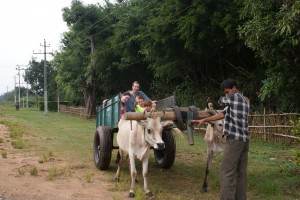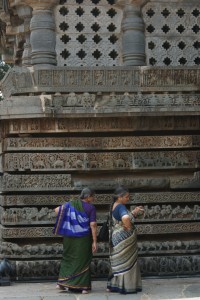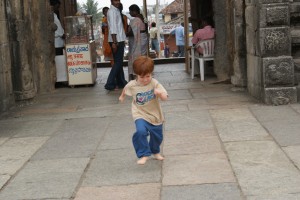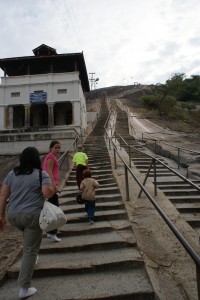Post #10
Hassan was our overnight base before visiting the World Heritage sites of Belur and Halebid.
We had noticed that the hotel offered rides in a bullock cart, and so, after breakfast, four of us crammed into a wooden cart with hay on the floor behind our “driver” and his emaciated bullock. We then rode along the highway for a while before turning into a side street where we rumbled past houses in a neighbouring village. It almost felt as though we had gone back in time a couple of hundred years, but amazingly, bullock carts are an everyday feature on the roads of Karnataka today. While clearly we were foreigners identifiable to all around us, our driver and our cart fitted in perfectly and we passed many other carts on the way. Indian highways are like that – a huge jumble of vehicles ancient and modern all going their own way.
We loved our bullock-cart ride – the pace was slower than riding on a bicycle, yet it seemed so natural to be driving around a village in the morning in the back of a cart in rural Karnataka.
Half an hour later and back in the modern world we left our hotel and made our way to Belur and Halebid. Ancient temples, incredible carvings and an excellent guide who made it all interesting for the kids made for an outstanding visit. The carvings are intricate and tell many different stories – stories from Hindu mythology as well as depictions of daily life from nearly a thousand years ago. On one of the walls our guide pointed out the carved figure of a tourist from all those years ago – different facial features with obviously very different clothing – clearly while under construction the temples were a site of great interest to foreigners, as they remain today.
What we loved so much was the fact that we were the only foreign tourists at the site – many Indian tourists wandered about, but clearly we were well off the foreigner tour bus route, and much happier as a result. I have no problem visiting a site that is popular amongst tourists – one expects that of places acknowledged to be of significance to the whole of humanity – but it does feel really special when those tour buses are absent – the feeling of exploring a special site that others have somehow missed make the overall visit that much more interesting.
We left the temples and began the long drive to Mysore. On the way we passed the scene of a horrific accident – in a small town a truck hit a pedestrian, killing him on the spot, very close to our car. Raja our driver screamed at the kids to close their eyes, and so thankfully they didn’t see the terrible scene. We did see the driver jump out of the truck and run away – we learned that in situations like that it is would not be uncommon for the driver to be lynched before the police arrived, and apparently he was running for the protection of the police station.
We continued, and in the late afternoon arrived at the city of Shravanabelagola – site of the huge free standing statue of the naked Jain saint Gomteshwara. The statue was carved over a thousand years ago and is massive – we could see it from the highway for at least fifteen minutes before we arrived. On neighbouring hills we saw huge electricity generating windmills – just a further sign of the ongoing paradox that one sees in India on a daily basis – ancient next to modern, modern next to ancient.
The statue stands on top of a huge hill and we climbed the hill barefoot along with hundreds of others. A great site, the statue very simple in its execution and really very peaceful. We enjoyed the story of how the site was chosen. A great warrior-god stood on an opposite hill a few kilometers away and shot his arrow across the city – where the arrow landed, the statue was built. Clearly we were not going to question the story.
Unfortunately our three year old was bitten by a red ant up on the hill, but we were carrying ointment with us that stopped the pain and his crying. We left soon after, arriving in Mysore after dark.
PS These days I’m planning great family trips to India myself. For more info on what I can do for your family, visit here.




